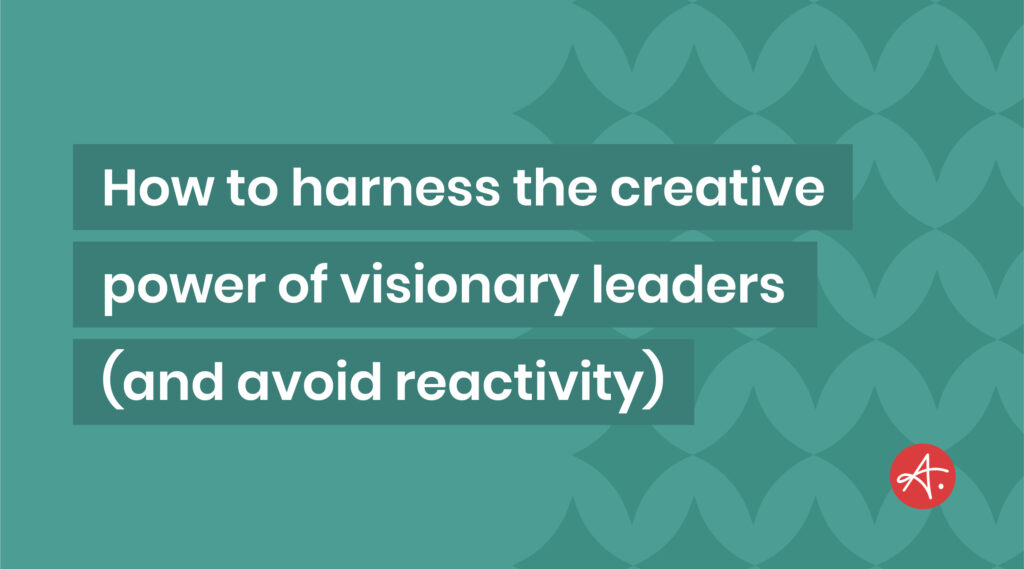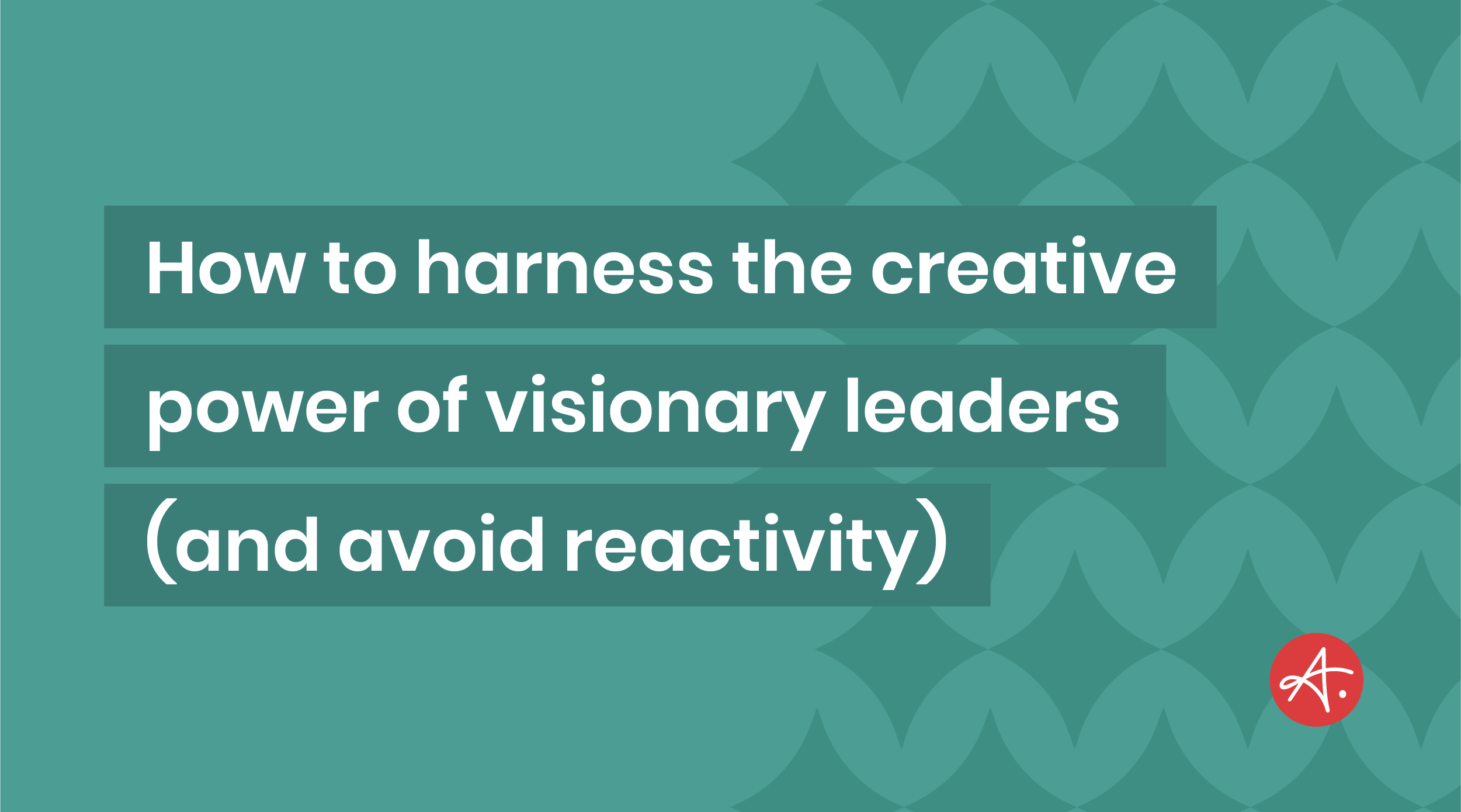
Many growing businesses are led or were started by creative visionaries. The passion of these visionaries is a significant asset to their organizations. But for marketers, it can create challenges. New ideas from visionaries can feel like orders to act, leading to teams committing random acts of marketing that lack clarity and focus.
We invited several of Authentic’s fractional CMOs and peer advisors, John Ryan, Christy Joyce, and Jay Crain, to share how marketing teams can harness the creative power of their leaders and visionaries to add richness — rather than randomness — to their programs.
- What have you seen happen as the result of a marketing team not being able to harness the creative power of their leaders effectively?
Jay: Not harnessing the creative power of a leader can compromise and leave behind “the why.”
Why does the company exist? Why does it do what it does? And where did that initial motivation for the product or service come from? (Similar to Simon Sinek’s rant on the subject.)
Marketers can overcome this by cultivating effective storytelling. Most leaders are powerful storytellers. The marketing team should capture the details of these stories and, where appropriate, integrate them into everything from top-line messaging to potential marketing tactics.
Christy: When a marketing team is not harnessing the creative vision of their leader, they will lack brand consistency, continually missing the mark on fulfilling the company’s mission, vision, story, promise, and “why.”
In doing so, the team’s efforts will lose impact due to brand inconsistency and randomness, and they will yield a lesser return due to limited strategy and focus. Over time, the team will experience a loss of enthusiasm for the brand and its marketing efforts, and they will likely experience higher frustration.
Companies can overcome this by ensuring the visionary leader (and the marketing team):
- Articulates the brand’s “why” and its story to every employee (e.g., through onboarding, brand guidelines, and demonstrated consistency).
- Communicates a clear, overarching mission with strategy and goals (utilizing tools such as the Authentic Growth® Marketing Maturity Matrix) to keep everyone thinking creatively but also on track.
Brainstorming and creativity are imperative as long as the marketing team remains focused on the agreed-upon key goals.
John: The symptoms of when the marketing team is having trouble with the company’s leaders include:
- Marketers fill the void, and that’s more expensive than collaborating with leadership.
- Leaders are not seen as market visionaries. Instead, they’re seen as opportunistic or followers.
- Competitors who are aligned appear stronger and get positioned as thought leaders.
What happens too often is the executive who suddenly gets inspired and wants to be a thought leader in the market. Leaders must realize that being a thought leader is a long game that demands consistency. Looking back, everyone will see this as a missed opportunity and will be unable to explain why they couldn’t get it together as a team.
- How can a marketing function elevate itself from a place of reactive execution to one that advises creative leaders on the best next step?
John: Most of the responsibility is on the CEO to invite marketing to the “grown-ups” table. Perhaps you have such a great and unique product that it sells itself. Great! Count yourself as part of the lucky few. For most companies, essential outcomes rely on limited resources. Marketing leadership needs a green light to strategize, lead, and win with the CEO’s full support. With the CEO’s backing:
- Marketing is less reactive
- Prioritization becomes easier
- Marketing metrics connect to the mission
- Foresight and predictability improve through better planning
CEOs must understand that every job in the company benefits from (and even relies on) strong awareness and demand generation. After all, each is necessary to succeed as a business. I wouldn’t work with a CEO who doesn’t “get this” because they are limited in their vision and create obstacles to growing the company’s valuation.
Jay: Focus on outcomes. Get face time with your visionary leader to make sure you get answers to these fundamental questions:
- What are we trying to accomplish?
- Which markets are we trying to open up?
- What audiences are we trying to appeal to?
- What numbers are we trying to hit?
Establishing these elements first with the creative visionary allows you to back into strategies and tactics more likely to connect to set goals.
This sets the marketing team up to be a more proactive organization with more targeted, measurable campaigns.
Christy: Shifting a marketing function from reactive to proactive and strategic requires several considerations. First, it’s critical to have an experienced marketing executive participate in leadership meetings to understand the overall company objectives and professionally and tactfully push back on the reactionary habits of visionary leaders.
When the marketing executive has a seat at the leadership table, they can more effectively assess what’s happening in marketing today and identify what the team needs to focus on to support the growth of the business. At Authentic, we use various assessment tools within our Authentic Growth® Methodology to understand the current state of marketing at our clients’ organizations.
Once there’s a solid understanding of what’s happening today, marketing leaders can establish specific goals that support the business objectives. Then, they can set a specific and planned annual strategy with dates and KPIs. Sharing a marketing plan that ties back to business objectives helps marketers serve as strategic advisors to creative visionaries.
Skilled marketing leaders can also help the marketing team stay focused on goals, which helps create a ‘heads up versus heads down’ mindset to deliver the right results.
- How can marketing teams make sense of the creative power of leaders, identify what’s most important, and put their ideas to good use?
Christy: Marketers can better understand creative leaders and identify priorities when they ask the right questions. (E.g., Does this new idea fulfill the mission? Does it achieve a set goal? Is it measurable? Why are you recommending this idea?) Answers to these questions help create context about whether this is something to delay but keep on the radar or consider something more urgent (i.e., prioritizing). This way, a marketing team doesn’t lose sight of the good, creative ideas, and the visionary leader knows they’ve been heard. But everyone stays focused on the set goals.
A marketing team should also measure efforts to gather data about whether or not they’re successful. Data helps the team decide whether to continue a marketing activity, iterate on an activity, or chalk something up to a learning experience they shouldn’t continue investing in. These insights help reinforce the tactics and strategies established by a marketing team to achieve set goals. A creative leader can then see how ‘one’ good idea could be fruitful.
John: It would be best if you had good conversations about how the leaders see their ecosystems, categories, company, and goals. In essence, how do they see their world? If the leader were to step into the future in five years, how do they view this market? How have we improved things for the buyer?
As a company, you can design backward from these answers to see if your company can lead the category. Seeing what’s possible in the future should be part of the company’s leadership. Here’s how it helps:
- The company knows how it will change the world
- Messaging cuts through the noise because it’s different
- Marketing priorities become clearer (knowing what you won’t do is powerful)
“Thunder is great, thunder is impressive, but it’s the lightning that does the work.” – Mark Twain
I feel the same way about ideas and execution. Ideas are great, but it’s the execution that does the work. Marketing leaders need regular and candid talks with their CEO to make achievements easier and more rewarding.
Jay: Create context. This relates back to outcomes.
Marketers can set better metrics and report on them when a leader can define what success looks like and rank outcomes by importance.
Once you establish data and reporting and know how the company is tracking — good or bad — the team now has a more specific context to ask leaders for more creative feedback on how to improve in any given situation or overcome challenges.
The central theme for all of these is asking more and better questions. Not just accepting corporate speak and high-level, poorly defined initiatives.
When marketers effectively harness the creative power of visionaries, these visionaries can be instrumental in a company securing a differentiated position in the market and establishing the organization as a thought leader. But wrangling the many ideas of creative visionaries is not without its challenges and, often, random acts or marketing. Companies with creative visionaries need the support, guidance, and strategic expertise of experienced marketers to leverage the visionary’s full potential as a market-shaping leader.

Our Authentic™ Fractional CMOs have worked with creative visionaries across all business types, stages, and sizes. They know how to build productive, strategic relationships with visionaries, ultimately leading companies toward healthy growth. Let’s connect if you’d like to discuss how one of Authentic’s fractional CMOs could vet your big ideas and support your business.





